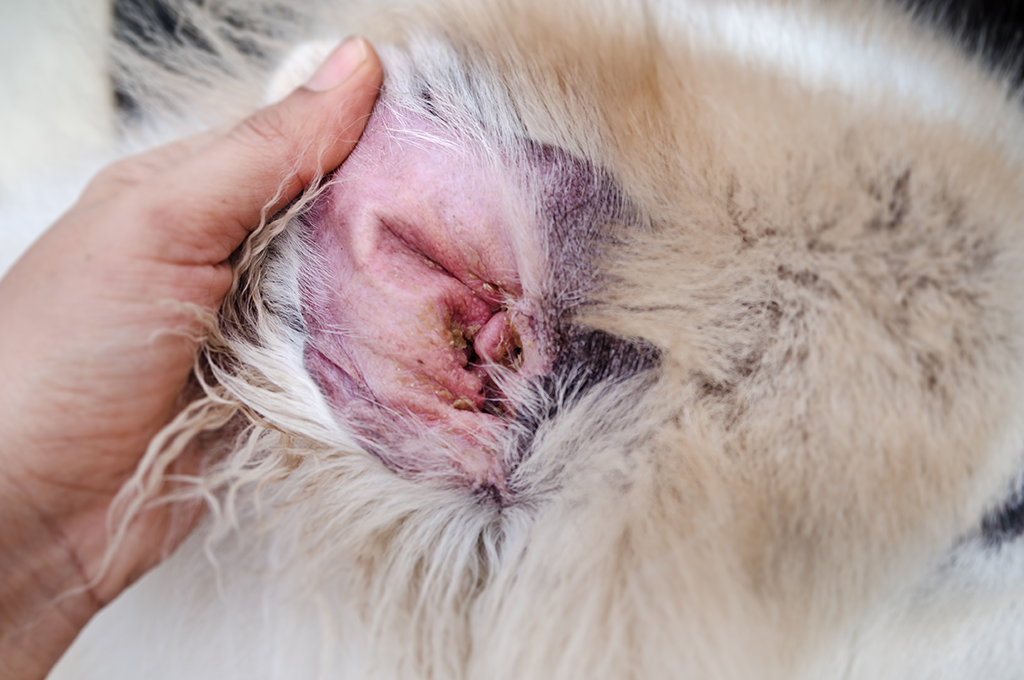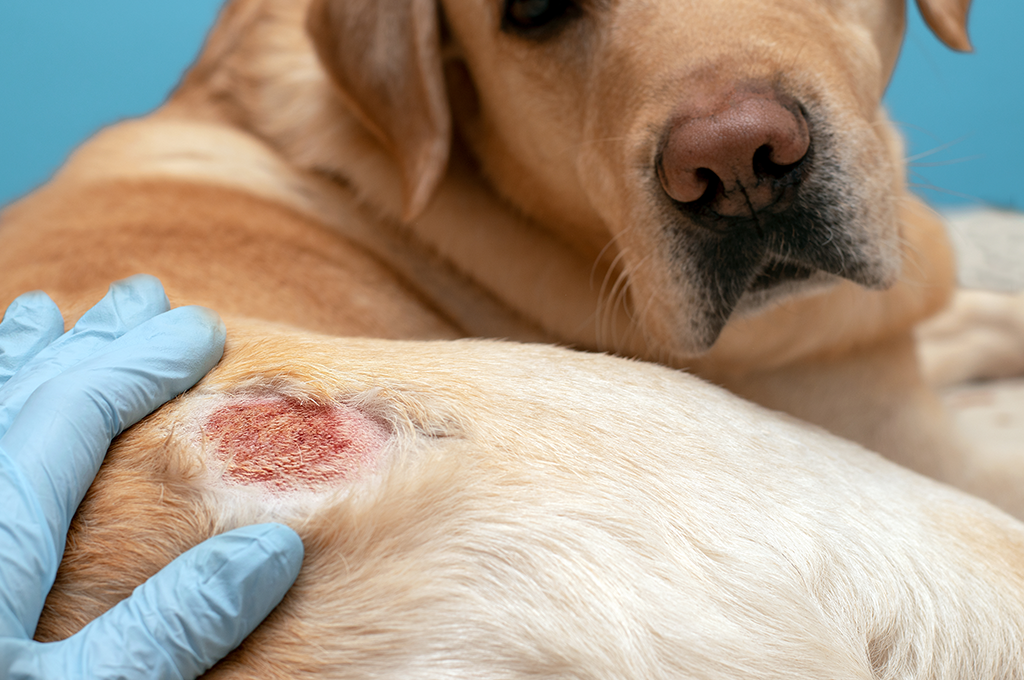ATOPIC DERMATITIS IN DOGS AND CATS

WHAT IS ATOPIC DERMATITIS?
Atopic dermatitis is an allergic skin disease that can affect both cats and dogs. Certain breeds are more likely to get atopic dermatitis than others, such as Golden Retrievers, Bulldogs and most , but it can occur in all dogs and cats.
Your pet may have an allergic reaction to something they have come in contact with around the house or garden. It can be difficult to diagnose atopic dermatitis, as there are many different causes, so if you think your pet has an allergy it’s best to speak to your vet.
WHAT ARE THE SYMPTOMS OF ATOPIC DERMATITIS?
There are a few common symptoms of atopic dermatitis. They can include:
Rashes and redness,
Itchy skin
Hair loss (also known as alopecia)
Infections (commonly skin and ear infections)
Overgrooming
Dark, thickened skin
Weepy eyes
Hot spots (also known as Acute Moist Dermatitis)
Greasy skin
A yeasty smell
The areas most affected by atopic dermatitis are:
Ears
Paws
Armpits
Face
Groin
Your pet may only have one or two of the above symptoms to identify it has an allergic reaction. There are many causes of atopic dermatitis so if your pet is showing any of the above symptoms you should speak to your vet and they will be able to help you work out what your pet is allergic to.

WHAT CAUSES IT?
The cause of atopic dermatitis can sometimes be difficult to find. You may know that they’re allergic to something, but it may not be easy to determine what the specific allergy is. Some allergies are seasonal whereas others occur all year round. So, it’s best to speak to your vet and they can help you narrow down the cause of the allergy.
Some of the main causes of atopic dermatitis are allergies to:
Pollen
Dust mites
Fleas
Food
Grass
Moulds
These are just some of the common causes of atopic dermatitis, but your pet may not be allergic to any of these things and still have the condition. Your vet will be able to help you identify what your pet is allergic to.

HOW IS ATOPIC DERMATITIS DIAGNOSED?
If your vet suspects your pet has atopic dermatitis, they may look at your pet’s medical history first, to confirm if the symptoms are all year round or if they occur seasonally. If the symptoms occur seasonally then your pet may have an allergy to pollen whereas if the allergy occurs all year round there may be something else causing the reaction.
Most vets will diagnose atopic dermatitis by completing some or a mixture of different tests and ruling things out as they go along.
For example, if they suspect the allergy is linked to food, your vet may recommend a controlled diet for your pet to try and determine the root cause of the allergy. Alternatively, your vet may complete allergy tests to find the best treatment if your cat or dog is allergic to an inhalant or fleas. Or, they may complete blood and skin tests to rule out any other allergies.
HOW IS IT TREATED?
As there are many different causes for atopic dermatitis, there are many different ways you can treat the condition. If you know what your pet is allergic to, the best thing to do is to avoid causing the allergic reaction as much as possible. This may mean walking your dog or only letting your cat go outside when the pollen count is lower or avoiding certain foods in your pet’s diet.
If you don’t know the cause of pet’s atopic dermatitis there are still things you can do to help relieve the symptoms when they occur. Below are some treatments which could help your pet.
Antihistamines
Antihistamines can help relieve the itchiness associated with the skin allergy. There are several types of antihistamines which you can use on pets so speak to your vet to find out which one will be best for your pet.
Medicated Baths
There are some topical shampoos which can help calm your pet’s skin. These types of shampoo normally contain medication which can help with reducing inflammation and soothing the skin. Also, bathing your pet more frequently can help wash away allergens.
Flea Control
You should regularly treat your pet for fleas along with other pets in your household. If your pet has a flea allergy you may require a stricter flea treatment plan to minimise a flare up.
Anti-itch Medication
There are some medications that can help reduce the itchiness of the allergy. They can either be in the form of tablets or injections. Your vet will be able to discuss different anti-itch medications available for your pet.
Immunotherapy
If you know the cause of the allergy, then immunotherapy may be an option. It involves injecting your pet with small doses of what they are allergic to, to help them get used to it. The injections are provided in small doses over a long period of time. This can help your pet react less to what they are allergic to over time but could take a long time for it to be effective. It may also cause the pet to have symptoms of the allergy whilst they build up resistance so other treatments may be required alongside this.
Hypoallergenic Diet
If your vet thinks your pet is allergic to a certain type of food, then they may need to go on a specific diet to try and determine the specific allergy. According to the Animal Medical Centre of South , the most common allergies in dogs are dairy, beef and wheat so they should be avoided when feeding your pet a hypoallergenic diet.
These are just a few different treatments for atopic dermatitis but there may be a better treatment for your pet depending on the root cause of the allergy. Once your vet has helped you narrow down the cause, you can find the best treatment to minimise the impact of the allergy.

HOW CAN IT BE PREVENTED?
There is no way of preventing atopic dermatitis as it’s caused by an allergic reaction to something and you may not be 100% sure that is. If your pet does have atopic dermatitis, you can help relieve the symptoms that occur to help your pet live a happy life. Your pet may experience flare ups of the allergy on the odd occasion and to treat them you may need additional help from your vet. If the symptoms are managed, then your pet should be able to live a happy life.
CONCLUSION
Overall, atopic dermatitis is an allergy which can occur in dogs and cats. The cause of the allergy can sometimes be difficult to diagnose but once you know the cause, you can work out the best treatment for your pet.
Atopic dermatitis isn’t always resolved in the first visit to your vet and may require ongoing treatment for the symptoms of your pet’s allergy. So, you may want to think about taking out pet insurance to help support you with some of the unexpected and ongoing costs*. At The Insurance Emporium, our Pet Insurance can include cover for Vet’s Fees up to £8,000** to help in case of an accident or illness. What’s more, our Pet Insurance products are Defaqto 5 Star Rated^! Head on down to The Insurance Emporium to see if we have the right cover for you!
* The Insurance Emporium cover does not include hypoallergenic diet.
** Vet’s Fees cover up to £8,000 available on lunar or calendar monthly Lifetime Gold Pet Insurance products.
^ Defaqto 5 Stars on selected products
Blog was originally written in 2020 and has been updated in line with current practices as of 2021. All content provided on this blog is for informational purposes only. We make no representations as to the accuracy or completeness of any information on this site or found by following any link on this site. We will not be liable for any errors or omissions in this information nor for the availability of this information. We will not be liable for any loss, injury or damage arising from the display or use of this information. This policy is subject to change at any time.







